|

Youth delegates arriving for the conference |
15th World Conference on Youth concludes :
Sri Lanka makes great strides to integrate youth in development
By Naalir Jamaldeen
The 15th World Conference on Youth concluded last Friday. The
conference was held from May 7 to 9 an BMICH. The inaugural ceremony was
held at Magam Ruhunupura International Convention Centre (MRICH)
President Mahinda Rajapaksa was the Chief Guest at the inaugural
ceremony.
The "World Conference on Youth 2014" focused attention on challenges
faced by youth, the solution and the role of youth in the post 2015
development agenda. Youth representatives from 162 countries
participated in the inaugural ceremony and the conference. Many problems
such as unemployment and several other problem which obstruct the
development and empowerment of youth. Twenty six Youth Affairs Ministers
across the globe also participated.
The main theme of the Conference was "Main Stream in youth in 2015
Agenda" giving priority to youth. The main discussion included the role
of youth in setting up the goal after 2015 and what kind of steps should
be taken to empower them the and their contribution towards the country
and the society. In line with the main event several side events, round
table discussions were also held.
|

President Mahinda Rajapaksa is addressing the
gathering |
|

UN General Assembly Chairman John W Ashe
while addressing the conference |
The first International Task Force (IYTF) was appointed consisting of
20 youth, 10 from Sri Lanka and 10 from other countries.
Discussions were held under seven themes such as realising equal
access to quality education, full employment and entrepreneurship,
poverty eradication and food security, promoting healthy lives and
access to health, environmental protection, emergency preparedness and
youth centered urbanisation, realising peace, reconciliation and ending
violence and ensuring inclusive recreation, sports and cultures.
While addressing the event President Mahinda Rajapaksa said that Sri
Lanka proposed to host this conference at the UN High-Level Meeting on
youth at the UN General Assembly in 2011 based on the reasons such as
addressing increasing challenges faced by youth. The current population
of Sri Lanka is 20 million and 26 percent out of them are youth.
The President said that after the eradication of terrorism the hope
among youth towards a better and progressive Sri Lanka and that have
been restored. There will be three billion young people in the world by
2015. it is an important global strategy is developed to accept youth
focus and ensure their participation in the current and future
development programs at national, regional and global levels.
"The primary responsibility to ensure youth participation in
development lies with the state. We as leaders and policy makers need to
consider the number of challenges to make effort meaningful and
successful", the President said. "The minds of youth are susceptible to
influence and can be easily misguided. This is the attraction for terror
groups to recruit youth combatants to their cadres" President Rajapaksa
said.
Sri Lanka over the last couple of years took large strides to
integrate youth in the development process. One of the main and
productive policy initiatives taken by the Government is creating a
Youth Affairs and Skills Development Ministry by amalgamating Ministries
such as Technical and Vocational Education and Training and Youth
Affairs. The Ministry brought institutions which are engaged in youth
development under one umbrella, according to Youth Affairs and Skills
Development Minister Dullas Alahapperuma.
He said that the mechanism to organise youth in the country is an
important area in youth development which is done through the network of
youth clubs set up in each village. Currently there are 14,000 youth
clubs functioning across the country over 600,000 members have joined so
far in those clubs.
"Besides, Sri Lanka has launched the National Youth Policy (NYP) this
year. The NYP was formulated based on three pillars such as ensuring
youth, enabling youth and empowering youth. Likewise Sri Lanka initiated
many more youth development programs for the sake of youth.
Bathiya and Santhush sang the theme song which was written by
Minister Dullas Alahapperuma.
|

First Lady Shiranthi Rajapaksa being welcomed |
A magnificent inaugural ceremony was held and cultural items were
showcased. The youth delegates who represented various countries across
the world were clad in clothes which depict their cultural and
traditional values,
When the UN set out the millennium development goal in 2000 by world
leaders committing their countries to a new global partnership to reduce
extreme poverty and setting out time-bound goals on meeting the needs of
world,s poorest. These goals to be achieved by 2015 formed the basis for
what are known as the eight millennium goals, which have been broken
down into 21 quantified targets that are measured by 60 indicators.
Many youth marginalised from social economic opportunities, with
limited access to essential resources. Eighty seven percent of youth
population live in developing countries, nearly 45 percent youth across
the world living on less than two dollars per day. Youth are among the
most vulnerable of all persons of Millennium Development Goals (MDGs)
aim to reach targets. Whether it is poverty, hunger lack of education,
maternal morality, unemployment, environmental degradation or HIV/AIDS,
the impact on young people can be far greater than on their older
counterparts.
This is because many young people often lack access to
information, schooling opportunities for civic participation and
engagement, social influence and back rights, and are often overlooked
in national development agendas. Therefore young people participation to
achieve the goals are crucial to ensure successful and sustainable
development.
|

A cultural item staged during the inaugural ceremony |
Sri Lanka as a member state of United Nations and committed to UN
Charter is working diligently to fulfill its national global
responsibilities in achieving the millennium development goals. Sri
Lanka's aim to achieve MDGs is spearheaded by the Ministry of Finance
and Planning, with the support of the UN Country team and with direct
implementation assistance from the UNDP. The National Council for
Economic Development (NCED) brings together stakeholders from private
and state sectors to develop economic policies and action plan.
The Mahinda Chinthana 10 year development goal framework" clearly
specifies the Government's commitment for the achieving of MDGs for all
Sri Lankans across the entire country. The Government in its budget
preparation has called to relate MDG key performance indicators of
Ministries to budgetary process. With the peace and stability returning,
Sri Lanka has a unique opportunity to focus more on MDGs, especially
addressing those related to regional imbalances. While Sri Lanka is well
on track in achieving most of the MDGs targets by 2015 at national level
to localise MDGs at private and regional level. Sri Lanka is constantly
seeking to adopt innovative methods in working with youth in achieving
goals.
Young people are vital to society, "Today's adolescents and youth are
shaping social and economic development, challenging social norms and
values, and building foundation of the World's future". "Youth movements
and groups are challenging traditional power structures and advocating
for new social contracts between state and society. Youth have
demonstrated their ability and potential to be positive agents of change
who can help solve the problems that surrounded the planet's present and
future. |

